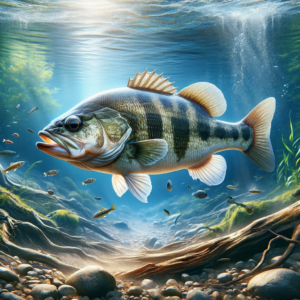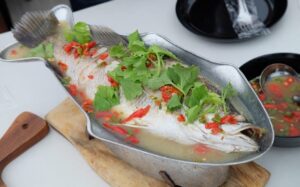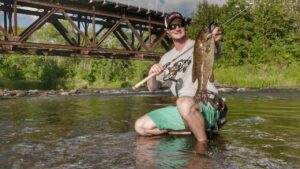Have you ever wondered what smallmouth bass eat? If so, you’re in the right place! In this article, we will discuss the diet of smallmouth bass in detail, so you can understand what these fish feed on and how it impacts their overall behavior. So, let’s dive in and explore the fascinating world of smallmouth bass diet!
Smallmouth bass, like many other fish species, are opportunistic predators. They have a diverse diet that consists of both plant and animal matter. Insects, crayfish, smaller fish, and even small mammals like mice and shrews can all be on the menu for these voracious predators. Smallmouth bass are also known for their knack for hunting in shallow rocky areas and ambush points, using their excellent sense of sight and lateral line to detect movement and vibrations in the water.
Understanding the diet of smallmouth bass is crucial for anglers and conservationists alike. By knowing what smallmouth bass eat, anglers can choose the right lures and bait to increase their chances of hooking these prized game fish. Conservationists can also monitor the availability of specific prey species in smallmouth bass habitats to ensure the overall health and balance of the ecosystem. In the following paragraphs, we will delve deeper into the specific types of prey that smallmouth bass target, providing you with a comprehensive understanding of their diet. Stay tuned to learn more about the fascinating feeding habits of smallmouth bass!
Understanding the Diet of Smallmouth Bass
Overview of Smallmouth Bass Diet
Smallmouth bass (Micropterus dolomieu) are a species of freshwater fish known for their spirited fight when caught on the line. Native to North America, smallmouth bass are highly sought after by anglers due to their aggressive nature and ability to put up a good fight. In order to gain a better understanding of how to effectively target smallmouth bass, it is crucial to comprehend their dietary preferences. This article will delve into the various prey items consumed by smallmouth bass, including insects, fish, crustaceans, amphibians, small mammals, birds, and even vegetation.
Prey Items Consumed by Smallmouth Bass
Smallmouth bass are opportunistic predators with a wide-ranging diet. They are known to consume a variety of prey items depending on availability and their own physiological requirements. Their feeding habits can vary greatly depending on the specific body of water they inhabit, including rivers, lakes, and streams. Let us now explore the different categories of prey items commonly consumed by smallmouth bass.
Insects and Invertebrates
Insects and invertebrates play a significant role in the smallmouth bass diet. Smallmouth bass have a particular affinity for aquatic insects, such as mayflies, caddisflies, and stoneflies. These insects are often found near the surface of the water and provide an abundant source of food for smallmouth bass. Additionally, smallmouth bass will also feed on terrestrial insects that happen to fall into the water, including grasshoppers, beetles, and ants. Their diet is not limited to insects alone, as they also consume a diverse array of other invertebrates, including crayfish, worms, snails, and leeches.
Fish as a Major Component of Smallmouth Bass Diet
Fish make up a significant portion of the smallmouth bass diet, especially in larger specimens. Smallmouth bass have a remarkable ability to capture and consume a wide variety of fish species. They are known to prey upon minnows, shiners, darters, sunfish, and even their own species, including young smallmouth bass. Smallmouth bass are agile hunters and use a combination of stealth and speed to ambush their prey. They rely on their sharp vision and acute sense of hearing to detect the movements of their prey, and then strike with lightning speed, engulfing their target in a swift gulp.
Crustaceans and Amphibians
Crustaceans, such as crayfish, are another important prey item for smallmouth bass. Crayfish are widely abundant in many freshwater ecosystems and provide a high nutritional value for smallmouth bass. Smallmouth bass will readily consume crayfish whenever the opportunity arises, especially during periods when crayfish are more active, such as at night or during the warmer months. Amphibians, particularly frogs and tadpoles, also form a part of the smallmouth bass diet, especially in areas where they are abundant.
Small Mammals and Birds
Although small mammals and birds are not the primary prey for smallmouth bass, there have been documented cases of smallmouth bass consuming small mammals such as mice and voles. These instances are relatively rare and typically occur when small mammals come into close proximity to the water, often due to accidental falls or deliberate swimming. Birds, on the other hand, may occasionally become prey for smallmouth bass if they are near the water’s surface or land on the water’s edge. These occurrences, however, are infrequent and do not constitute a significant portion of the smallmouth bass diet.
Vegetation and Plant Matter
Contrary to popular belief, smallmouth bass are not strictly carnivorous. While the main components of their diet consist of insects, fish, and other animal matter, smallmouth bass have also been observed consuming vegetation and plant matter. They are known to consume algae, aquatic plants, and even fruits and berries that happen to fall into the water. These plant materials provide additional nutrients and can serve as a supplement to their predominantly animal-based diet.
Factors Influencing Smallmouth Bass Diet
Several factors influence the diet of smallmouth bass, including environmental conditions, prey availability, and their own physiological requirements. The availability of suitable habitat and prey resources directly impacts the composition of their diet. The temperature and clarity of the water, as well as the presence of underwater structures and vegetation, play a significant role in determining the abundance of prey items. Smallmouth bass are known to adapt their diet according to the prevailing conditions in order to maximize their foraging efficiency and meet their energy needs.
Seasonal Variations in Smallmouth Bass Diet
The diet of smallmouth bass can also vary seasonally. During the spring and summer months, when water temperatures are warmer, smallmouth bass tend to be more active and will feed more frequently. Insects and other invertebrates are abundantly available during this time, and smallmouth bass will opportunistically feed on them. As the weather cools in the fall, smallmouth bass will start to consume more fish, which are still active and abundant. During the winter, smallmouth bass become less active and may reduce their feeding activity. They may rely on stored energy reserves and consume less food during this period.
Conclusion
Understanding the diet of smallmouth bass is essential for any angler hoping to successfully target this popular game fish. Smallmouth bass are opportunistic predators, consuming a wide variety of prey items, including insects, fish, crustaceans, amphibians, small mammals, birds, and even vegetation. Their diet is influenced by several factors, including environmental conditions and seasonal variations. By gaining insight into the dietary preferences of smallmouth bass, anglers can better select appropriate lures and techniques to effectively catch these prized fish. So, next time you cast your line, remember the diverse diet of smallmouth bass and use this knowledge to increase your chances of a successful catch.




